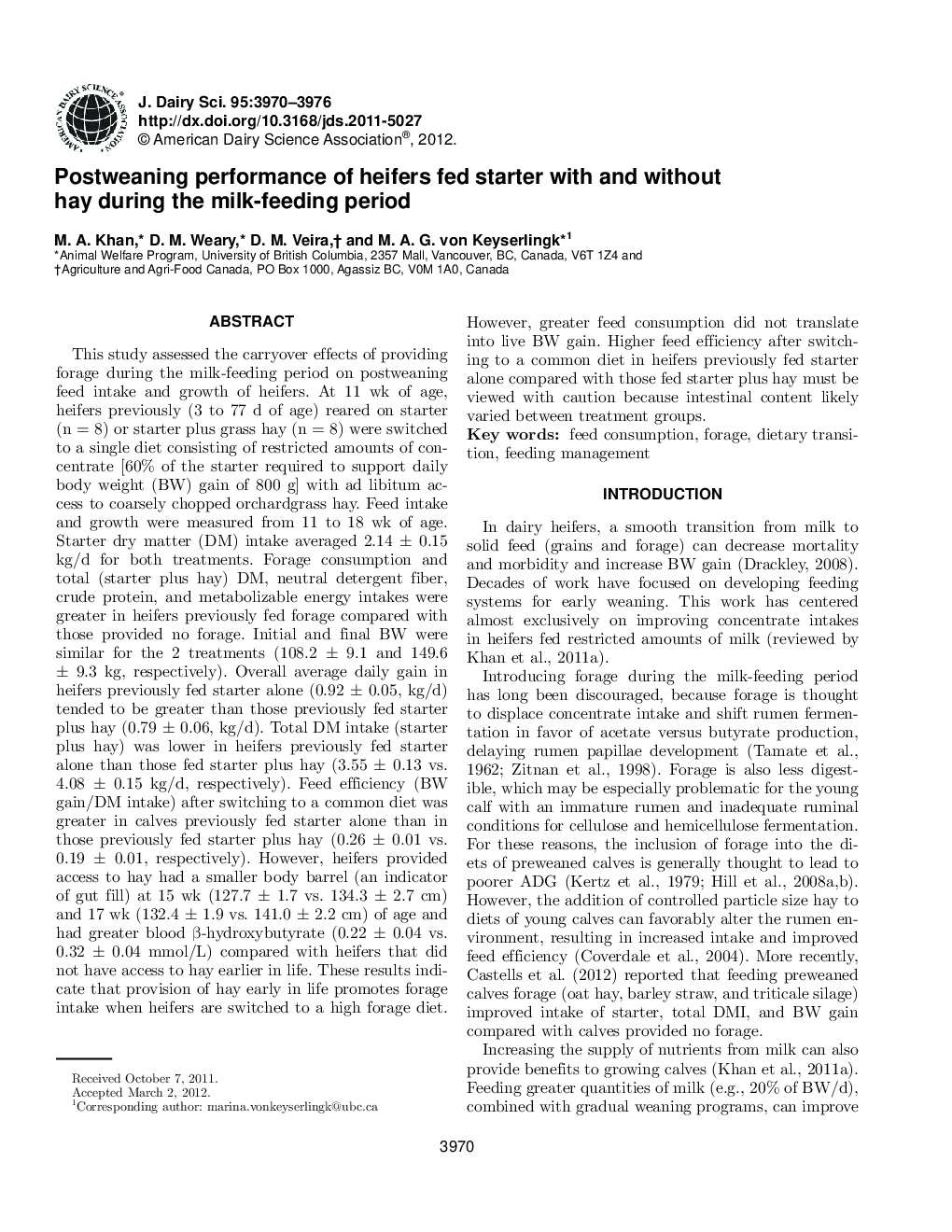| کد مقاله | کد نشریه | سال انتشار | مقاله انگلیسی | نسخه تمام متن |
|---|---|---|---|---|
| 10979746 | 1108065 | 2012 | 7 صفحه PDF | دانلود رایگان |
عنوان انگلیسی مقاله ISI
Postweaning performance of heifers fed starter with and without hay during the milk-feeding period
دانلود مقاله + سفارش ترجمه
دانلود مقاله ISI انگلیسی
رایگان برای ایرانیان
کلمات کلیدی
موضوعات مرتبط
علوم زیستی و بیوفناوری
علوم کشاورزی و بیولوژیک
علوم دامی و جانورشناسی
پیش نمایش صفحه اول مقاله

چکیده انگلیسی
This study assessed the carryover effects of providing forage during the milk-feeding period on postweaning feed intake and growth of heifers. At 11 wk of age, heifers previously (3 to 77 d of age) reared on starter (n = 8) or starter plus grass hay (n = 8) were switched to a single diet consisting of restricted amounts of concentrate [60% of the starter required to support daily body weight (BW) gain of 800 g] with ad libitum access to coarsely chopped orchardgrass hay. Feed intake and growth were measured from 11 to 18 wk of age. Starter dry matter (DM) intake averaged 2.14 ± 0.15 kg/d for both treatments. Forage consumption and total (starter plus hay) DM, neutral detergent fiber, crude protein, and metabolizable energy intakes were greater in heifers previously fed forage compared with those provided no forage. Initial and final BW were similar for the 2 treatments (108.2 ± 9.1 and 149.6 ± 9.3 kg, respectively). Overall average daily gain in heifers previously fed starter alone (0.92 ± 0.05, kg/d) tended to be greater than those previously fed starter plus hay (0.79 ± 0.06, kg/d). Total DM intake (starter plus hay) was lower in heifers previously fed starter alone than those fed starter plus hay (3.55 ± 0.13 vs. 4.08 ± 0.15 kg/d, respectively). Feed efficiency (BW gain/DM intake) after switching to a common diet was greater in calves previously fed starter alone than in those previously fed starter plus hay (0.26 ± 0.01 vs. 0.19 ± 0.01, respectively). However, heifers provided access to hay had a smaller body barrel (an indicator of gut fill) at 15 wk (127.7 ± 1.7 vs. 134.3 ± 2.7 cm) and 17 wk (132.4 ± 1.9 vs. 141.0 ± 2.2 cm) of age and had greater blood β-hydroxybutyrate (0.22 ± 0.04 vs. 0.32 ± 0.04 mmol/L) compared with heifers that did not have access to hay earlier in life. These results indicate that provision of hay early in life promotes forage intake when heifers are switched to a high forage diet. However, greater feed consumption did not translate into live BW gain. Higher feed efficiency after switching to a common diet in heifers previously fed starter alone compared with those fed starter plus hay must be viewed with caution because intestinal content likely varied between treatment groups.
ناشر
Database: Elsevier - ScienceDirect (ساینس دایرکت)
Journal: Journal of Dairy Science - Volume 95, Issue 7, July 2012, Pages 3970-3976
Journal: Journal of Dairy Science - Volume 95, Issue 7, July 2012, Pages 3970-3976
نویسندگان
M.A. Khan, D.M. Weary, D.M. Veira, M.A.G. von Keyserlingk,